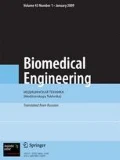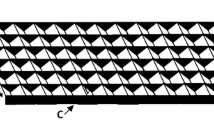Computerized emission tomography is an effective method for the diagnosis of pathological states in the human body. A new emission tomography approach was developed involving the use of multiplexed measurement systems (MMS). An iterative algorithm implementing the back projection method for emission tomography based on MMS was developed using hexagonal coding collimators. Numerical modeling demonstrated the validity of the proposed method.
Similar content being viewed by others
References
Hong, J. S., Vadawale, S. V., Grindlay, J. E., and Narita, T., “Laboratory coded-aperture imaging experiments: Radial hole coded masks and depth-sensitive CZT detectors,” Proc. SPIE, 5540, 63-72 (2004).
Fedorov, G. A., Radiation Introscopy - Information Encoding and Optimization of Experiments [in Russian], Atomizdat, Moscow (1982).
Ivanov, O. P., Semin, I. A., Safronov, A. M., and Toritsyn, O. S., “Tests of an iPIX system for visualization of gamma radiation fields at the Kurchatov Institute Science Research Center,” ANRI, 89, No. 2, 66-70 (2017).
Gmar, M., Gal, O., Le Goaller, C., et al., “Development of coded- aperture imaging with a compact gamma camera,” IEEE Trans. Nuc. Sci., 51, No. 4, 1682-1687 (2004).
Haboub, A., MacDowell, A. A., Marchesini, S., and Parkinson, D. Y., “Coded aperture imaging for fluorescent X-rays,” Rev. Sci. Instr., 85, No. 6, 35-40 (2014).
Chi, W. and George, N., “Optical imaging with phase-coded aperture,” Optics Express, 19, No. 5, 4294-4300 (2011).
Cieslak, M. J., Gamage K. A., and Glover, R., “Coded-aperture imaging systems: Past, present and future development – A review,” Rad. Meas., 92, 59-71 (2011).
Gottesman, S. R., Isser, A., and Gigioli, G. W., “Adaptive coded aperture imaging: Progress and potential future applications,” Proc. SPIE, 8165, 816513-816521 (2011).
Fedorov, G. A. and Tereshchenko, S. A., Computerized Emission Tomography [in Russian], Energoatomizdat, Moscow (1990).
Starfield, D. M., Rubin, D. M., and Marwala, T., “High transparency coded apertures in planar nuclear medicine imaging,” Proc. 29th Ann. Int. Conf. IEEE EMBS, 4468-4471 (2007).
Utkin, V. M., Kumakhov, M. A., Blinov, N. N., et al., “The MiniScan mobile gamma camera and results from its use,” Med. Fizika, No. 1, 42-53 (2007).
Kazachkov, Yu. P., Semenov, D. S., and Goryacheva, N. P., “The use of coding apertures in medical г cameras,” Prib. Tekhn. Eksperim., No. 2, 131-139 (2007).
Accorsi, R., Design of Near-Field Coded Aperture Cameras for High-Resolution Medical and Industrial Gamma-Ray Imaging, Ph.D. Thesis, Department of Nuclear Engineering, MIT (2001).
Tereshchenko, S. A., Methods in Computerized Tomography [in Russian], Fizmatlit, Moscow (2004).
Fedorov, G. A. and Tereshchenko, S. A., “Multiplexed Systems for the detection of ionizing radiation. 1. Codes and encoders,” Meas. Techn., 38, No. 11, 1287-1297 (1995).
Fedorov, G. A. and Tereshchenko, S. A., “Integral code systems for recording ionizing radiation: Iterative image reconstruction algorithms for focal plane processing,” Meas. Techn., 44, No. 4, 422-427 (2001).
Fedorov, G. A., Tereshchenko, S. A., Antakov, M. A., and Burnaevskii, I. S., “Point spread functions of integral-code measurement systems with multiple-pinhole hexagonal coding collimators,” Meas. Techn., 55, No. 5, 574-582 (2012).
Fedorov, G. A., Tereshchenko, S. A., Antakov, M. A., and Burnaevsky, I. S., “Unipolar and bipolar measurement schemes for reconstruction of the spatial distribution of radiation sources using hexagonal coding collimators,” Med. Tekhnika, No. 1, 43-45 (2014).
Fedorov, G. A. and Tereshchenko, S. A., “Extended pseudorandom sequences and two-dimensional coding collimators based on them,” Meas. Techn., 50, No. 6, 681-689 (2007).
Lalush, D. S. and Wernick, M. N., “Iterative image reconstruction,” in: Wernick, M. N. and Aarsvold, J. N. (eds.) Emission Tomography. The Fundamentals of PET and SPECT, Elsevier (2004), pp. 443-472.
Vengrinovich, V. L. and Zolotarev, S. A., Iterative Methods in Tomography [in Russian], Beloruskaya Navuka, Minsk (2009).
Fedorov, G. A., Dmitriev, A. M., Tereshchenko, S. A., and Antakov, M. A., “Reconstruction of images of the spatial distributions of sources of ionizing radiation on the basis of iterative back projection in multiplexed coding measurement systems,” ANRI, 68, No. 1, 62-70 (2012).
Author information
Authors and Affiliations
Corresponding author
Additional information
Translated from Meditsinskaya Tekhnika, Vol. 51, No. 6, Nov.-Dec., 2017, pp. 46-49.
Rights and permissions
About this article
Cite this article
Tereshchenko, S.A., Fedorov, G.A., Antakov, M.A. et al. A Back Projection Method for Hexagonal Coding Collimators in Emission Tomography with Multiplexed Measurement Systems. Biomed Eng 51, 441–445 (2018). https://doi.org/10.1007/s10527-018-9766-3
Received:
Published:
Issue Date:
DOI: https://doi.org/10.1007/s10527-018-9766-3




